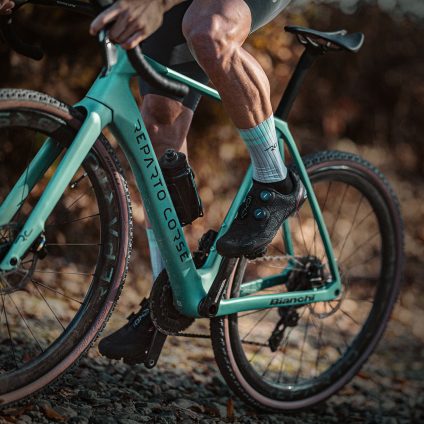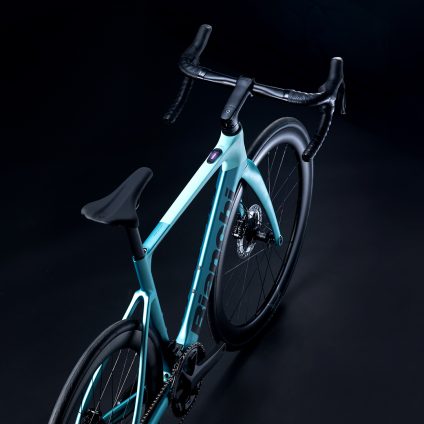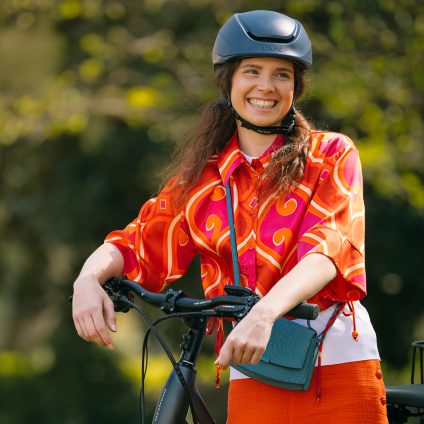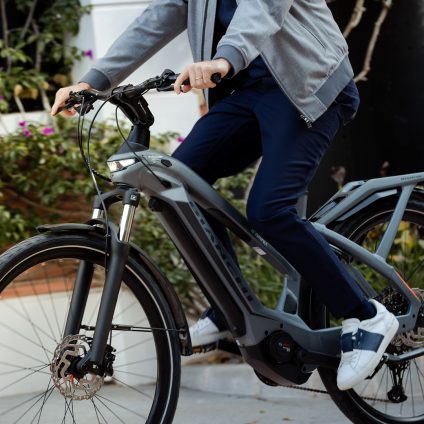1885
1930
Our origins
The history of Bianchi parallels Italy’s, one that has pedalled the unmistakable celeste turquoise bicycles. Edoardo Bianchi started working at an early age and in 1885, just 20 years old, he opened his first workshop.

FIRST STORE AND WORKSHOP
The premise he rented in Via Nirone was a stone’s throw from the centre of Milan. He was selling penny-farthings but also surgery instruments under a “Repair Shop” sign because the bikes were only some of the objects inside. In the century that ended, the first velocipede competitions began, and Bianchi was already a protagonist. In 1899, Bianchi took its first international victory over the line at the Grand Prix de Paris with Gian Fernando Tommaselli. He went on to become the first CEO of Bianchi, showing already the close relationship between the racing world and our company.

GIAN FERNANDO TOMMASELLI
Edoardo Bianchi continued to pedal, and with more force, so much so that he was already moving for a second time due to the demand for bicycles and the need for workshop space. Venturing into other sports was necessary for some but for Edoardo Bianchi, passion and a curiosity of mechanics pulled him to the world of cycling and in 1897, the combination led him to experiment with the internal combustion engine. A successful and forward-looking choice since motor vehicles with our brand name were produced up until the 1960s.
The passion spread and Bianchi was already a recognised name climbing passes and in social circles. Even the king and queen of Italy were intrigued by this pedalling vehicle that could take you so far without too much effort. Their interest quickly grew and Edoardo Bianchi put them in the saddle and personally followed them during their first rides. His effort was well rewarded because Bianchi became the ‘official supplier of the Royal Family.’ The brand grew, undisturbed by the economic crisis and, in 1907, gave birth to the joint-stock company called Società Anonima Edoardo Bianchi, employing 400 workers. Bianchi had transformed and developed the bicycle. That first model, built with a big front wheel, was covered with dust from the winds of change, and those same winds brought innovation and technological research.

FACTORY IN VIALE ABRUZZI, MILAN
In the dark silence of the Great War that arrived, Bianchi became synonymous with mechanical efficiency and speed. The name, already strong, came to be a virtually unique supplier of the Bersaglieri soldiers. Futuristic concepts went into those bicycles made for the 1915 military. Bianchi invented the fullsuspension bike, a sector he would lead in a few years later. They were just looking for a little bit of comfort to withstand the huge loads that soldiers were forced to carry. But the system, despite the heavy materials, was highly innovative.

FIRST FULL-SUSPENSION MTB
In those early years of the new century, the colour that would later characterise Bianchi’s bicycles was born. The Celeste Bianchi changed slightly in tone over time, becoming clearer and closer to the green, but without losing its strong link to our brand.
Next story Back to timeline1940
1950
Fausto Coppi
Bianchi managed to overcome the difficulties of the Second World War and the death of Gian Fernando Tommaselli in 1944. Two years later, when Edoardo Bianchi died, his son Giuseppe took the reins of the company.

Fausto Coppi
And just like cyclists themselves, Bianchi is able to bring out its best in the most difficult moments. The legend of Fausto Coppi, already known as an excellent cyclist, took off in Bianchi’s white and celeste jersey. The stories behind the 1947 Giro d’Italia win and then the 1949 Tour de France title became some of the most beautiful and recognised in Italy.
Next story Back to timeline1960
1980
The Growth
Together with Coppi, Bianchi transformed, changing cycling and Italy. Team sponsorships arrived and the celeste brand became so strong in cycling that Bianchi was able to mitigate the decline of its motorbike production. Heading towards the 1970s, and the oil crisis, Bianchi opened the factory in Treviglio, near Bergamo, that spanned 75,000 square metres.

Felice Gimondi
The Bianchi industry evolved, seeing a handful of ownership changes. In 1972, Angelo Trapletti and his brothers bought the company. In 1973, the enormous production potential propelled ahead with Felice Gimondi’s world jersey becoming an icon of Italy, that – not only in cycling – never gives up and manages to find victory with strength and dedication. In 1991, Piaggio acquired all the shares, adding Bianchi to other brands in its property.
Next story Back to timeline1990
2000
Pantani
The 20th century saw another explosion in bicycling with mountain bikes. Bianchi followed with victories, taking the Downhill World Championship title with Bruno Zanchi in 1991.
Another key milestone was about to happen. Salvatore Grimaldi and his Cycleurope company burst onto the scene in 1997, taking over the brand and pushing it into the ‘top brands’ Olympus by blending history and the most advanced technological research.

Salvatore Grimaldi
Riding a very light aluminum bicycle, Marco Pantani famously tossed away his bandana to take the Giro d’Italia and Tour de France in one go in 1998. Cycling, not only in Italy, went crazy for the small bald climber known as ‘The Pirate’.

Marco Pantani
Next story Back to timeline2000
Present
The Evolution
A few years later, the legendary white and celeste Bianchi jersey returned to the peloton with German Jan Ullrich and his team. Our company was the sole sponsor. It allowed those of the Coppi generation to remember and those of the new generation to dream. Julien Absalon did so, and took the gold medal at the Athens Olympics in 2004 while riding a Bianchi mountain-bike.

Julien Absalon
The Celeste Bianchi became synonymous with victories and style. The company, edging always towards excellence, made precise strides in developing technologies. In 2010, Bianchi made an important step in the world of cycling with a bicycle that enhanced aerodynamics and exploited the stiffness and lightness of carbon fibre in a very successful design with the release of the first Oltre.
Bianchi’s innovation continued in the high-end range. The Infinito CV, in 2013, revolutionised cycling with the introduction of the Countervail® technology, a patented carbon fibre developed for NASA aerospace operations, able to cancel up to 80% of the vibrations. It represented a true advancement, an exclusive feature also applied to the ultra light Specialissima model introduced in 2015.

Lars Boom – Tour de France 2014
Also in 2015, Bianchi won the Under 23 World Champion cross-country title in mountain biking. Bianchi invested more and more in this sector, leading to the creation of the Methanol CV in 2016, a mountain bike engineered with Countervail®, as Bianchi through the years develops new CV models with the same technology in the road and off-road sectors.

Bianchi Café & Cycles Stockholm
Over the 130 year history, Bianchi has become a lifestyle brand. The desire for the bicycle in everyday life, mixed with stylish Italian culture created an enduring image. With that in mind, Bianchi began the first Bianchi Café & Cycles in Stockholm, then one in Milan and Tokyo. We took the elegance and refined taste of the Bianchi bikes, with the cafe culture, to the major cities. Bianchi’s evolution is now but the future still waits to be written, to take us forward, which will be done via our passion and continuous technological research.










































